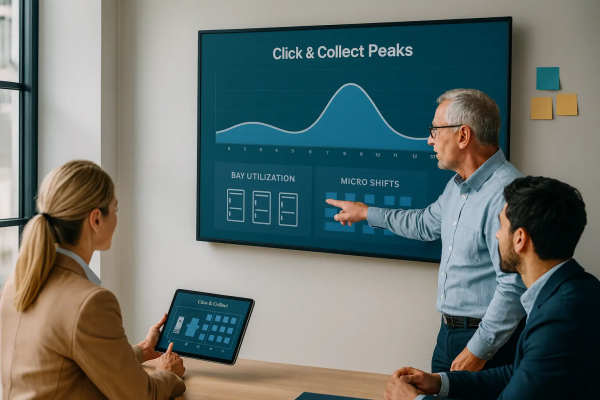Retail: Click-and-Collect Staffing That Works
Click-and-collect (BOPIS, curbside, lockers) promises “online speed with store convenience,” but it only sings when labor matches real-time demand. Spikes hit before lunch, after work, and right before carrier cutoffs; meanwhile, aisles need coverage and backrooms need runners. The fix isn’t more bodies—it’s a demand-shaped roster, clearer roles, and fast coordination powered by a smart workforce platform that keeps rules and reality in sync.

Forecast the hour, not the day
Daily staffing targets hide the peaks that break service. Build hourly curves from POS orders, app traffic, historical BOPIS creation times, promo calendars, and weather. Split demand into:
- Picking (backroom/aisle pulls),
- Handoffs (curbside, counter, lockers),
- Exceptions (substitutions, age checks, split orders).
Translate curves into per-hour coverage by zone, not just a single “C&C” headcount. Treat locker maintenance, returns bursts, and cap-ex deliveries as scheduled demand so they don’t collide with the 17:00 rush.
Design a shift architecture built for C&C
Human-friendly blocks beat heroic overtime. Aim for coverage without idle time.
Micro-shifts for predictable spikes
Use 3–5-hour boosters aligned to BOPIS waves (e.g., 11:00–14:30, 16:30–20:00). These reduce paid idle at 15:00 and keep energy high at 18:00.
Overlap windows at handoffs
Add 60–90 minutes of overlap around shift changes so curbside bays don’t clog and counters don’t stall while pick lists roll over.
Define the “runner” role
Runners bridge backroom and bay: scanning, staging, and communicating ETAs. When runner coverage is thin, everything slows—even if pick capacity was fine.
Skill tags and guardrails, baked in
Every roster needs the right mix: substitution-savvy pickers, licensed age-checkers, locker pros, and a manager with override permissions. Put these as skill tags in the scheduler so illegal/unsafe assignments are blocked and overtime risks surface before they happen. Guardrails (rest windows, minors, union rules) should live in the plan—not in a supervisor’s memory.
Cross-train for elasticity
C&C is a system of handoffs. Cross-train aisle staff to backroom picks, pickers to handoffs, and cashiers to age checks. Maintain a small flex pool you can redeploy every 60–90 minutes based on live backlog. Publish the rotation so it feels fair and predictable—morale matters when the lot fills up.
Coordination your frontline actually feels
Schedules answer who/when; execution needs what/why. Mid-shift promos, “item X out of stock,” or locker faults must reach the right people instantly. Enterprise-grade team management lets managers broadcast updates once (with roles/languages), attach quick checklists (substitution script, bay reset), and capture shift notes that transfer cleanly at handoff. Staff see the next priority on mobile—no noisy chats, no missed calls.
Time capture = truth for next week’s roster
If everyone’s time is logged as “front-end,” you can’t fix bottlenecks. Capture at task/zone (picking, runner, curbside, lockers) so you can see where minutes evaporate. Flag missed punches, overlaps, and unapproved overtime before payroll close. The side effect is huge: cleaner actuals make next week’s forecast smarter.
KPIs that predict guest happiness
Skip vanity averages; track the moments that matter:
- Pick-cycle time (order released → staged),
- Bay/Counter dwell (arrival → handoff),
- Ready-within-window % (e.g., 30 or 60 minutes by promise tier),
- Labor cost % by daypart (C&C vs. walk-in),
- Schedule stability (changes <72h, late stay-overs, call-ins).
When pick-cycle flattens and dwell drops, NPS climbs—and refunds for missed windows fade.
Customer experience blueprint
Set a visible promise (“ready in 30” during non-peak; “within 60” at peak) and align staffing to keep it real. Script substitution calls/texts so choices are fast and consistent. Keep bays clearly numbered, with QR/short codes that map to the order for hands-free confirmation. A calm, precise handoff beats a frantic sprint every time.
Pitfalls (and the quick fixes)
- Shadow spreadsheets. One “real” file off to the side equals version chaos. Kill them with live templates and audit trails.
- Bloated base shifts. Peaks belong to micro-shifts; base should be lean and steady.
- Unowned runners. Name the role, train it, schedule it.
- Silent exceptions. Any override should require a documented, time-boxed approval so “one-off” doesn’t become “always.”
The payoff
When demand shapes coverage, runners keep the flow, and communication rides a system instead of a group chat, click-and-collect feels effortless. You hit pickup windows, shrink curbside queues, and free managers from firefighting. Most importantly, customers get the same confident experience whether it’s Tuesday lunch or Saturday rush—exactly what brings them back.
Media Contact
Company Name: Shifton
Contact Person: Media Relations
Email:Send Email
Country: United States
Website: https://shifton.com/
